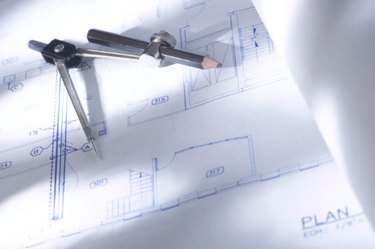
An isometric drawing displays the three-dimensional view of an object. Each height, depth and width are precisely measured before you begin making the drawing and laid out in a orthographic drawing. Isometric drawings are most commonly used in technical drawings, patents, and manuals. The common factor in all isometric drawings is that the height is always measured on the vertical, and the depth and width are measured at a 30 degree angle from the horizontal. To create an isometric drawing of an imagined objet just keep in mind the horizontal line and the 30 degree angles at all times.
Step 1
Draw a horizontal line across your page. Draw a short vertical line up from the horizontal line.
Video of the Day
Step 2
Line the rotary angle ruler up with the horizontal and vertical line. Make a small mark where the 30 degree point is on the left and the right side of the page. Use the flat end of the ruer to draw diagonal lines from the 30 degree marks to the point that the horizontal and vertical lines meet.
Step 3
Draw another vertical line, the same length as the first, upward from some point on the right diagonal line. The distance between the two vertical lines will determine the depth of the object. Erase the diagonal line that extend out further than the depth.
Step 4
Draw a vertical line up from the left diagonal line. Start the line, two lengths of the short vertical line, away from the vertical line. This will be the width of the object. The vertical line should end when it is double the length of the short vertical line. Erase the diagonal line that extends out further than the width All of the short lines should be the same length as the first short vertical line from here on out.
Step 5
Draw a short diagonal line to the left and starting from the top of the first short line drawn. The line should be parallel to the left diagonal line. Draw another short diagonal line from the top of the second short vertical line drawn, also parallel to the left diagonal line.
Step 6
Connect the tops of the short vertical lines with long diagonal line parallel to the right diagonal line. Connect the ends of the short diagonal lines with another line parallel to the right diagonal.
Step 7
Draw short vertical lines from the ends of the short diagonal lines, also connecting them with a parallel line. Finish the object by drawing two more short diagonal lines as you did in Step 5 and connecting them with one last parallel line. The front diagonal line should also meet the top of the long vertical line you drew in Step 4.
Step 8
Shade in the object with three colors. The left side of the object should all be one color, all of the top sides of the object should be another color and all of the right facing sides should be another color.
Tip
Add more steps to the simple staircase drawn to keep practicing measuring and drawing parallel lines. Try drawing another staircase facing the opposite direction.
Video of the Day